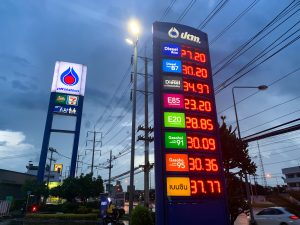PTT is the largest energy company in Thailand, and the Ministry of Finance is the controlling owner with a 51 percent stake. Including subsidiaries and joint ventures, the consolidated firm straddles the energy sector from oil and gas exploration and extraction to petrochemical production, refining activities, retail sales, and global trading. Thanks to skyrocketing energy prices, the last few years have been very good for PTT.
Revenue hit $96 billion in 2022, a 34 percent increase compared to 2019. PTT paid over $1.2 billion in dividends on $3.5 billion in after-tax profits last year. These windfall profits are similar to those of Petronas, the Malaysian state-owned energy giant which also had a tremendously good year in 2022. The pandemic dried up demand for oil and gas, but the revived post-pandemic economy sent energy prices soaring. And while surging energy prices are a good thing for PTT, they are not so great for consumers.
The Metropolitan Electricity Authority (MEA) is the primary distributor of electricity for Bangkok and surrounding areas. Although MEA’s sales are recovering from their pandemic slump, the utility still sold 3 percent less electricity in 2022 than it did in 2019. Despite selling less electricity, revenue was 9 percent higher than it was four years ago. The simple explanation is that the MEA is charging more for electricity than it did before the pandemic.
Electricity prices in Thailand include a base rate plus an Automatic Tariff Adjustment, which they call the Ft rate. The base rate reflects assumptions about the fixed costs of generating electricity. The Ft rate is a charge that can go up or down depending on changes in variable costs, like fuel. If the price of natural gas increases, it becomes more expensive to generate electricity. Some of this increased cost is passed onto consumers through a higher Ft rate. The rate is reviewed every few months by the Energy Regulatory Commission.
Throughout 2021, when households were being pummeled by the pandemic, the Ft charge was -15.32 satang per kWh (a satang is 1/100 of a baht). In 2021 and 2022, the price of fuels like coal, oil, and gas started spiking around the world. To prevent electricity generators from absorbing the entirety of these cost increases, the Ft rate started rising in January 2022, reaching 93.43 satang per kWh in September 2022. It is currently still above 90. This means since the end of last year, typical MEA customers in Bangkok have been paying nearly one baht above the base rate for each kWh of electricity they use.
Thailand is not alone here. EVN, Vietnam’s state-owned electric utility, tried to absorb higher energy costs and shield consumers for as long as it could before raising prices recently. EVN arguably waited too long, depleting its cash reserves considerably before finally asking consumers to share in the burden. Indonesia raised the price of gasoline in 2022, when eating the losses from high oil prices simply became untenable for public finances. The Philippines uses a similar system to the Ft charge, and utilities generally pass higher energy costs onto consumers.
This gives us a peek into a broader debate about who should pay and who should profit from higher prices during inflationary times. Should price increases fall primarily on consumers, while firms higher up in the production chain reap big profits? Should it be the power plants, or distributors like MEA, who absorb the price increases and accept lower profit margins? And who should be making these decisions? The market? The state?
Thailand’s answer to these questions is a regulated market approach. Firms like PTT stand to profit handsomely in times of high global energy prices. But those same high prices make generating electricity expensive, particularly if you import a lot of fuel as Thailand does. In the power sector, some of these cost increases are passed onto consumers through the Ft charge, subject to regulatory oversight from the ERC.
In this way, Thailand has tried to strike a balance between state and market mechanisms, as well as the interests of consumers and producers. But it is a balance that clearly requires and expects consumers to absorb a portion of regulated price increases during times of high inflation. Whether that balance is optimal or fair, and how it might change under future leadership scenarios, is a different and possibly even more interesting question.

































